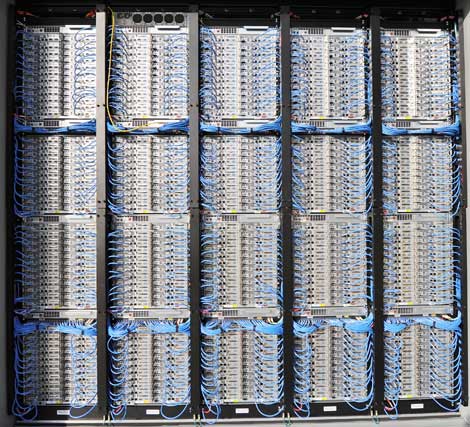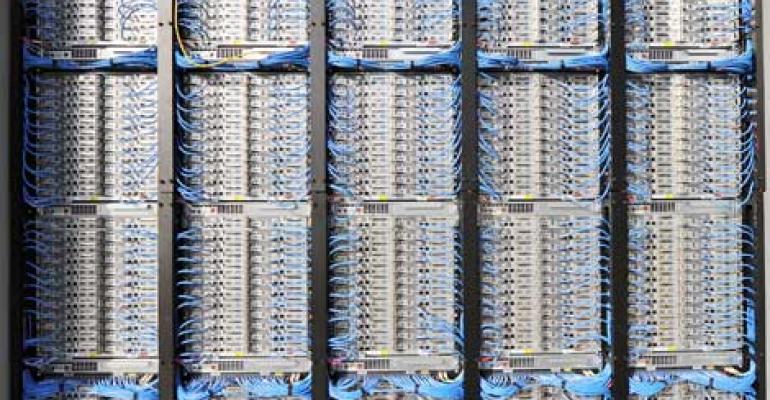
Packed racks of servers in a Microsoft IT-PAC module. Microsoft will use one of these modules in a test project in Cheyenne, Wyoming that will use biogas to power servers. (Photo: Microsoft Corp.)
When you see a pig farm, landfill or water treatment plant, can you envision a data center on that site? Microsoft can, and has major ambitions to tap sources of biogas to create a network of "off the grid" server farms to power its global cloud.
Microsoft's project to convert recycled waste into a data center energy source gets underway with its Data Plant pilot project in Cheyenne, Wyoming, which we wrote about last week. Today Microsoft is supplying additional details about the project, and what it may mean for the future of its global infrastructure.
The Cheyenne project will serve as a research site to test the Data Plant concept before it can be used in production data centers running Microsoft's more than 200 online services. A data center container with about 200 kW of IT load is being deployed next to the Dry Creek Water Reclamation Facility. The servers will run workloads from the University of Wyoming, which is partnering with Microsoft on the project. They'll be powered by electricity from a fuel cell running on methane biogas from the plant. Any power generated by the fuel cell that isn't consumed by the Data Plant will be sent back to the treatment facility to further reduce their energy costs. The heat from the fuel cell will also be reused in the water plants anaerobic digesters, which convert the waste into biogas.
'Bold New Paradigm' for Data Centers
Although the IT load is just a fraction of the size of Microsoft's cloud data centers - which can require upwards of 50 megawatts of power capacity - the knowledge acquired from the $8 million investment in the Cheyenne project will allow the company to model how the technology will work in a larger facility.
"With the Cheyenne research and development project, we are moving closer to the goal of a highly-available, net-zero CO2, scalable, and cost efficient data center," said Sean James, Senior Research Program Manager in Microsoft's Data Center Advanced Development unit. "This Data Plant project will help provide a bold new paradigm for future data center infrastructures that will recycle waste to power delivery of cloud services."
With the Data Plant concept, Microsoft hopes to brings compute and renewable energy infrastructure closer together. But it also expands the universe of power sources beyond traditional electric utilities. And that allows Microsoft to approach its infrastructure differently.
Today, huge data centers tend to converge on areas with large quantities of cheap power. The Data Plant concept allows Microsoft to unplug from the grid and tap a much larger network of facilities that produce biogas. Instead of a single huge data center serving an entire geographic region, Microsoft's network could become more broadly distributed, with a larger number of facilities housed at water treatment plants, farms and landfills.
Network of Off-Grid Data Centers
"What's compelling for us is that we see our data centers as an interconnected network," said James. "There's the ability to deploy 1 megawatt or 2 megawatt properties and string them together, especially as we go into regions where we have unreliable power resources."
Microsoft clearly has an eye on international expansion, where the Data Plant approach could bring improvements in reliability and sustainability. An example might be India, a country where the reliability of the power grid is so poor that some data centers use diesel generators as their primary power and the grid as backup. While that approach brings improved reliability, it also boosts the level of diesel emissions, which are pollutants.
In seeking renewable resources, Microsoft honed in on biogas rather than wind or solar, which are limited in geography and not always available around the clock. Making biogas work required some R&D.
"In general, biogas fuel sources are typically uneconomical to recover and convert to grid energy and are usually flared-off," James writes."By capturing and reusing biogas on premise with our data centers, we will be able to significantly reduce their carbon emissions while producing beneficial uses at the same time."
Water Plants Already Mission-Critical
Within the range of biogas sources, Microsoft likes water treatment plants. which "are great because they're already mission-critical," said James, and thus engineered for round-the-clock operations. "The biogas that comes from these facilities is consistent."
Microsoft isn't the first data center operator to use biogas in fuel cells. Both Apple and eBay are using biogas to support Bloom Energy Servers at new data centers, and Infinity SDC in the UK has used biomass for several years. But Microsoft says its program is distinctive for its focus on locating data center infrastructure alongside biogas sources, rather than tapping them from afar via pipelines. It is working with FuelCell Energy on the conversion.
"Our fuel cell technology is uniquely positioned to provide what other megawatt-class power generation products can't, which is efficiently converting renewable biogas into continuous baseload power right where the biogas is generated and in a manner that is virtually absent of pollutants," said Chip Bottone, President and Chief Executive Officer, FuelCell Energy, Inc. "The economics of our on-site power generation solutions are well suited for data centers, including the ability to use renewable biogas as a fuel source to provide carbon neutral power."
It's too early to say when Microsoft will begin using the Data Plant concept in production, but the strategy will be closely watched by the Microsoft team searching for new sites for the company's server farms.
"Our work in the energy sector, and the evaluation of renewable resources, is very tightly integrated with our site selection work," said Microsoft Utility Architect Brian Janous. "Energy is the oxygen of the cloud, and is at the very forefront of the site selection discussion."
The Cheyenne Data Plant proof-of-concept will launch next spring and run for about 18 months. At the end of the pilot project, Microsoft is donating the Data Plant - including the fuel cell, clean-up equipment, servers and modular data center - to the City of Cheyenne and the University of Wyoming for further research into this technology.





